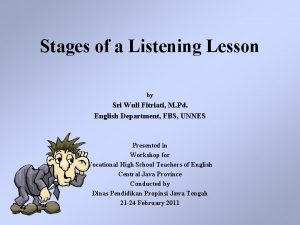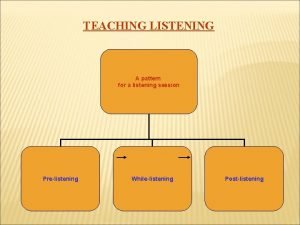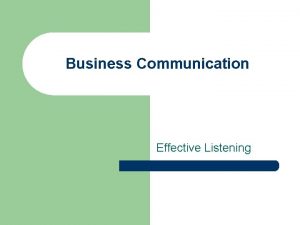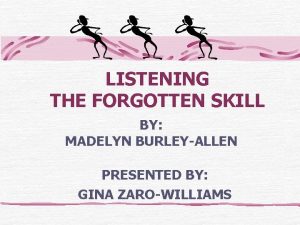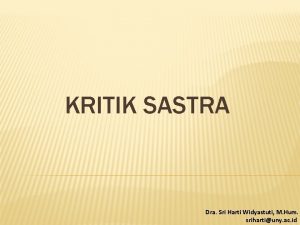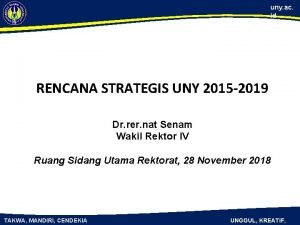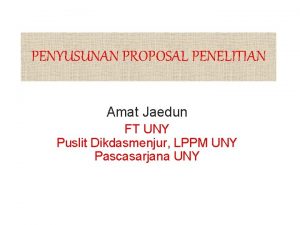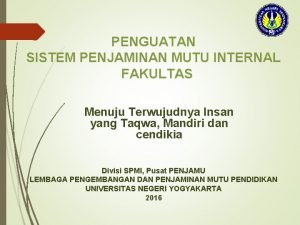Listening Skill 1 Yosa A Alzuhdy UNY Yosa













- Slides: 13

Listening Skill #1 © Yosa A. Alzuhdy - UNY © Yosa A. Alzuhdy – English Department TOEFL Preparation Bahasa Inggris MKU © Yosa A. Alzuhdy, M. Hum. yosa@uny. ac. id English Literature Study Program State University of Yogyakarta

TOEFL - Listening Comprehension 2 LISTENING SECTION TOEFL terdiri dari 3 bagian: Ø Part A : percakapan singkat, 1 percakapan – 1 pertanyaan Jumlah soal: 30 butir Ø Part B : percakapan panjang, 1 percakapan – 3 -5 pertanyaan Jumlah 2 percakapan (7 -9 butir soal) Ø Part C : Monolog / Pengumuman / Kuliah Jumlah 3 monolog (11 -13 butir soal) Ø TOTAL soal: 50 butir. © Yosa A. Alzuhdy - UNY Ø Bahasa yang digunakan American English, dengan aksen standard Amerika Utara, kecepatan berbicara normal. Ø Konteks percakapan tidak terlalu formal (kuliah, piknik, perpustakaan, asrama, kantin, sikap, pendapat, dsb. )

General Strategies: Listening 3 REMEMBER: © Yosa A. Alzuhdy - UNY 1. Don’t be late. Come in time to let yourself ready for the test. 2. Concentrate on the recording, don’t let anything draw your attention away from the test. 3. Read the answer choices before you listen, try to predict or assume the context from them. 4. Make “mental notes” on what you hear. 5. Mark your answer on the answer sheet first to save time for preparing to the next question. Fill in the complete oval later while listening to the instruction in part C. 6. If you cannot answer a question quite surely, just make a guess, and leave it. Go on to the next question, and get yourself ready.

Sample Question 4 Most of the questions in Part A focus on what the second speaker says. However, it is usually necessary to understand the entire dialog in order to choose the correct answer. E. g. M : Do you think I should leave this chair against the wall or put it somewhere else? W: Over by the window, I’d say. Q : What does the woman think the man should do? In your test book you will read: (A) (B) (C) (D) Open the window. Move the chair. Leave the room. Take a seat. © Yosa A. Alzuhdy - UNY From the conversation, you find out that the woman thinks the man should put the chair over by the window. The best answer to the question, What does the woman think the man should do? is (B). It will not be clear what the woman means when she says “Over by the window” unless you understand what the man says first. Do not choose an answer choice just because you hear the word said by the speaker. Usually, such options are only distractors.

Anticipating Questions 5 Ø Read ahead before you listen to the short conversation. Ø Anticipate the dialog from the answer choices, predicting what the question and the context of dialogs by considering the vocabularies. Ø There is a 12 -second pause between each dialog: - Answer the question as quickly as possible (mark the answer). - Preview the answer choices for the next item. (A) (B) (C) (D) Have a picnic. Go to the library. Study outside. Postpone the work until tomorrow. All answer choices start with a verb showing activity. Possible question: What will the speakers do next? © Yosa A. Alzuhdy - UNY (A) The gym doesn’t open until tomorrow. (B) He’s too busy to go to the gym. (C) There’s a special project going on at the gym. (D) The gym is full of kids. All options contain the word “the gym”. So, you might hear this word in the dialog. Focus on it, anticipate what can be understood / inferred about it.

p. 2 Exercise 0 6 1. (A) (B) (C) (D) Pleased Cold Disappointed Hungry All options are 4. (A) He left it in the lock adjectives (B) It’s still in his dorm room showing the (C) He put it in his pocket feeling (D) It doesn’t work in this lock Q (d) How does the man feel? Q (e) What does John say about the key? SET OF QUESTIONS : (a) What will tomorrow’s weather probably be like? (b) What had the woman assumed about Jim? Q (i) What will the woman do next? (c) What are these people doing? (d) How does the man feel? (e) What does John say about the key? 3. (A) Cloudy but much warmer (B) Rainy (f) What can be inferred about the (C) Clear but cold woman? (D) The same as today’s (g) What are they discussing? Q (a) What will tomorrow’s (h) Why did the man call Prof. Brown? weather probably be like? (i) What will the woman do next? . (j) What is the man’s problem? 2. (A) Go to her office (B) Call a taxi (C) Show the man where to find a taxi (D) Get directions © Yosa A. Alzuhdy - UNY

p. 2 Exercise 0 7 5. (A) He had given his textbooks to a friend. (B) He would receive more money. (C) He wouldn’t get to the bookstore on time. (D) He hadn’t sold his textbooks. 8. (A) (B) (C) (D) A A tuition increase. policy change. new class. recent proposal. Q (g) What are they discussing? Q (b) What had the woman assumed about the man? 6. (A) She’s probably an expert on modern art. (B) She didn’t paint the picture herself. (C) She’s just begun to study painting. (D) She probably doesn’t like SET OF QUESTIONS : modern art. (b) What had the woman assumed about Jim? (c) What are these people doing? 7. (A) He doesn’t have the right (f) What can be inferred about the notebook. woman? (B) He forgot to bring a pen. (C) He went to wrong lecture hall (g) What are they discussing? (h) Why did the man call Prof. Brown? (D) He was late for the lecture. (j) What is the man’s problem? Q (j) What is the man’s problem? Q (f) What can be inferred about the woman? © Yosa A. Alzuhdy - UNY

Similar Sounds / Sounds Confusion 8 Some sound-alike expression are minimal pairs: only one sound (vowel or consonant) is different: lack and luck, feel and fell, sheep and ship. peel and feel, vine and wine, stop and stock. Others contain part or a longer word: nation and imagination, mind and remind, give and forgive, press and express Or two words to one word: close it and closet, sent her and center. (Man) : I’ve never had this type of fruit before. I don’t know what to do with it. (Woman) : You just have to peel it and eat it. (Question) : What does the woman mean? © Yosa A. Alzuhdy - UNY You read: (A) (B) (C) (D) She doesn’t feel like eating fruit. The man should take the pill before eating. The fruit shouldn’t be eaten until it’s been peeled. She isn’t familiar with this type of fruit either. Ø If an answer choice contains a word that sounds like a word in the spoken sentence, that choice is usually wrong. Ø If an answer choice contains a word that sound exactly the same as the word in the spoken sentence, it’s not necessarily a correct answer.

p. 3 Exercise 1 9 1. (A) Get in a different lane. (B) Stand in another line. 2. (A) Go down the slide. (B) Play on the sled. 3. (A) Put them in a file. (B) Throw them in a pile. 4. (A) He can’t shut his suitcase. (B) His suitcase doesn’t fit in the closet. 5. (A) She made bread from whole wheat. (B) She baked some white bread. © Yosa A. Alzuhdy - UNY 2. 1. 3. 4. 5. slide wheat closet file –––-line pile –sled white close it lane M: How’s your job go? M: I’ve never had to. I put wait so long just for to pay W: M: What W: Did Where you kind should get ofbaby-sitting your bread suitcase did these Annie packed? letters bake? you? for a few groceries! W: IOh, fine–the children spent most line. of the day going down the W: think should another M: W: My M: Yeah Oh, favorite just –you but toss –now whole them I get can’t wheat in in that close bread! file. it. hill on their new sled. Q: the woman suggest man do? with the letters? Q: Whatdoes isdid does learned the man about woman mean? Annie? tell thethe man to do Q: What the children do?

p. 3 Exercise 1 10 6. (A) It’s being typed. (B) Brenda is taping it. 7. (A) Emily bought new clothes. (B) Emily recently moved. 8. (A) Its taste has improved. (B) It tastes slightly bitter. 9. (A) How much the ticket cost. (B) What Ellen might win. INTONATION To tell the truth: or STRESSING, showing negative is something result. important a dialog or conversation. 10. (A) It’s been chipped. W: Hi Jim, inhow’s the result of your exam? (B) There’s a ship inside it. Pay tothe thetruth… intonation in listening! M: attention To tell you I failed again. © Yosa A. Alzuhdy - UNY chip – ship typing taping (tape [vb]: put is on the tape record it) Emily’s price better –––dress prize bitter– Emily’s address 10. wonder ifathis oldfor bottle Idrawing, found is. Iworth any money. It’s a 9. M: 6. 7. 8. M: I Do W: Has I bought How’s you Brenda the have coffee ticket finished Emily’s here, writing address? the. Dennis? her story hope for the I win. radio news? beautiful color. W: She M: Oh, What’s It’s sure a has little the a–new she’s bitter, prize, one. just to. Ellen? tell Let taping the me it truth. see now. if I can find it for you. W: Yes, but look – there’s a chip in it. Q: Whatdoesthe thewoman Dennis man woman mansay ask mean? about Ellen? the coffee? story? Q: say about the bottle?

p. 3 Exercise 1 11 11. (A) He tripped in the aisle. (B) He slipped in some oil. 12. (A) For its fast horses. (B) For its natural resources. 13. (A) Thinking about the decision. (B) Arguing about the issue. 14. (A) The color is too bright. (B) It doesn’t fit around the neck. 15. (A) Wrote his name on the paper. (B) Told his student to write a paper. © Yosa A. Alzuhdy - UNY resources – horses, bright color – race collar sign tripped – –assign –tight, slipped, aisle – oilhorses think-thought – fight-fought 12. is. Jerry athe beautiful part of crutches. the state. it Maguire’s most famous 14. W: This I’ve never seen in on that shirt before. 15. 11. IAre saw you having is walking ayou midterm exam in Did Professor he have accident? class? 13. W: So, did committee finally reach a. What’s decision onanthat issue? for? M: IHis don’t itthey very often. oil, It’s too tight in the No, feet he wear assigned slipped ina fought some paper instead. and twisted his collar. knee. Finally, after ‘bout itheall afternoon! M: Well, you’ll see some remarkable race horses here. Q: is the problem with thedo? shirt? did happened Professor to Jerry? Maguire How did the committee spend the afternoon? Q: What Why is this area well known?

Quiz -12 Review Prepare yourself for A QUIZ… NOW! © Yosa A. Alzuhdy - UNY Open page 68 -69 (Review Test D) Do that in 15 minutes! Now open page 4 (Exercise 2) Listen and answer the

Sekian, terimakasih 13 That’s all for now. Thank you… © Yosa A. Alzuhdy - UNY
